Brain-derived neurotrophic factor signaling does not stimulate subventricular zone neurogenesis in adult mice and rats
- PMID: 19074010
- PMCID: PMC2659623
- DOI: 10.1523/JNEUROSCI.2918-08.2008
Brain-derived neurotrophic factor signaling does not stimulate subventricular zone neurogenesis in adult mice and rats
Abstract
In rodents, the adult subventricular zone (SVZ) generates neuroblasts which migrate to the olfactory bulb (OB) and differentiate into interneurons. Recent work suggests that the neurotrophin Brain-Derived Neurotrophic Factor (BDNF) can enhance adult SVZ neurogenesis, but the mechanism by which it acts is unknown. Here, we analyzed the role of BDNF and its receptor TrkB in adult SVZ neurogenesis. We found that TrkB is the most prominent neurotrophin receptor in the mouse SVZ, but only the truncated, kinase-negative isoform (TrkB-TR) was detected. TrkB-TR is expressed in SVZ astrocytes and ependymal cells, but not in neuroblasts. TrkB mutants have reduced SVZ proliferation and survival and fewer new OB neurons. To test whether this effect is cell-autonomous, we grafted SVZ cells from TrkB knock-out mice (TrkB-KO) into the SVZ of wild-type mice (WT). Grafted progenitors generated neuroblasts that migrated to the OB in the absence of TrkB. The survival and differentiation of granular interneurons and Calbindin(+) periglomerular interneurons seemed unaffected by the loss of TrkB, whereas dopaminergic periglomerular neurons were reduced. Intra-ventricular infusion of BDNF yielded different results depending on the animal species, having no effect on neuron production from mouse SVZ, while decreasing it in rats. Interestingly, mice and rats also differ in their expression of the neurotrophin receptor p75. Our results indicate that TrkB is not essential for adult SVZ neurogenesis and do not support the current view that delivering BDNF to the SVZ can enhance adult neurogenesis.
Figures

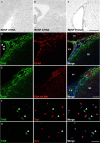


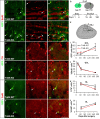
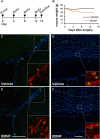
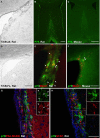
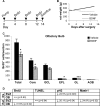
Similar articles
-
Variant brain-derived neurotrophic factor (Val66Met) alters adult olfactory bulb neurogenesis and spontaneous olfactory discrimination.J Neurosci. 2008 Mar 5;28(10):2383-93. doi: 10.1523/JNEUROSCI.4387-07.2008. J Neurosci. 2008. PMID: 18322085 Free PMC article.
-
p75 neurotrophin receptor expression defines a population of BDNF-responsive neurogenic precursor cells.J Neurosci. 2007 May 9;27(19):5146-55. doi: 10.1523/JNEUROSCI.0654-07.2007. J Neurosci. 2007. PMID: 17494700 Free PMC article.
-
Ciliary neurotrophic factor receptor regulation of adult forebrain neurogenesis.J Neurosci. 2013 Jan 16;33(3):1241-58. doi: 10.1523/JNEUROSCI.3386-12.2013. J Neurosci. 2013. PMID: 23325260 Free PMC article.
-
Brain ischemia, neurogenesis, and neurotrophic receptor expression in primates.Arch Ital Biol. 2011 Jun;149(2):225-31. doi: 10.4449/aib.v149i2.1368. Arch Ital Biol. 2011. PMID: 21701994 Review.
-
Neurotrophic factor control of adult SVZ neurogenesis.Dev Neurobiol. 2010 Apr;70(5):339-49. doi: 10.1002/dneu.20781. Dev Neurobiol. 2010. PMID: 20186714 Free PMC article. Review.
Cited by
-
Neurotensin-polyplex-mediated brain-derived neurotrophic factor gene delivery into nigral dopamine neurons prevents nigrostriatal degeneration in a rat model of early Parkinson's disease.J Biomed Sci. 2015 Jul 22;22(1):59. doi: 10.1186/s12929-015-0166-7. J Biomed Sci. 2015. PMID: 26198255 Free PMC article.
-
TrkB signaling directs the incorporation of newly generated periglomerular cells in the adult olfactory bulb.J Neurosci. 2013 Jul 10;33(28):11464-78. doi: 10.1523/JNEUROSCI.4812-12.2013. J Neurosci. 2013. PMID: 23843518 Free PMC article.
-
Genetic Increases in Olfactory Bulb BDNF Do Not Enhance Survival of Adult-Born Granule Cells.Chem Senses. 2020 Jan 1;45(1):3-13. doi: 10.1093/chemse/bjz058. Chem Senses. 2020. PMID: 31562506 Free PMC article.
-
BDNF, Brain, and Regeneration: Insights from Zebrafish.Int J Mol Sci. 2018 Oct 13;19(10):3155. doi: 10.3390/ijms19103155. Int J Mol Sci. 2018. PMID: 30322169 Free PMC article. Review.
-
Reduced levels of brain-derived neurotrophic factor contribute to synaptic imbalance during the critical period of respiratory development in rats.Eur J Neurosci. 2014 Jul;40(1):2183-95. doi: 10.1111/ejn.12568. Epub 2014 Mar 26. Eur J Neurosci. 2014. PMID: 24666389 Free PMC article.
References
-
- Anderson KD, Alderson RF, Altar CA, DiStefano PS, Corcoran TL, Lindsay RM, Wiegand SJ. Differential distribution of exogenous BDNF, NGF, and NT-3 in the brain corresponds to the relative abundance and distribution of high-affinity and low-affinity neurotrophin receptors. J Comp Neurol. 1995;357:296–317. - PubMed
Publication types
MeSH terms
Substances
Grants and funding
LinkOut - more resources
Full Text Sources
Other Literature Sources
Molecular Biology Databases
Research Materials
Miscellaneous
